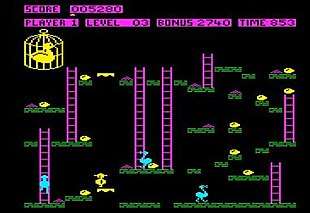Chuckie Egg
| Chuckie Egg | |
|---|---|
 | |
| Developer(s) | A&F Software |
| Publisher(s) |
A&F Software Pick & Choose |
| Designer(s) | Nigel Alderton[1] |
| Platform(s) | BBC Micro, ZX Spectrum(initially original) , Dragon, Acorn Electron, C64, MSX, Einstein, Amstrad CPC, Atari 8-bit, Amiga, Atari ST, IBM PC |
| Release | 1983 |
| Genre(s) | Platform |
| Mode(s) | 1-4 players alternating |

A&F Software's Chuckie Egg is a home computer video game released in 1983, initially for the ZX Spectrum, the BBC Micro and the Dragon. Its subsequent popularity saw it released over the following years on a wide variety of computers, including the Commodore 64, Acorn Electron, MSX, Tatung Einstein, Amstrad CPC and Atari 8-bit family. It was later updated and released for the Amiga, Atari ST, and IBM PC.
The game was written by Nigel Alderton,[1] then 16 or 17 years old. After a month or two of development, Nigel took a pre-release version of his Spectrum code to the two-year-old software company A&F, co-founded by Doug Anderson and Mike Fitzgerald (the "A" and "F", respectively). Doug took on the simultaneous development of the BBC Micro version, whilst Mike Webb, an A&F employee, completed the Dragon port. Chuckie Egg went on to sell over a million copies and remained a steady earner for A&F, who eventually went under in the latter half of the 1980s.[2]
The versions fall broadly into two groups — those with realistic physics (e.g. the BBC Micro and Amstrad CPC versions) and those without (e.g. the ZX Spectrum version). Although there is a substantial difference in play between the two, levels remain largely the same and all the 8-bit versions have been cited as classics.[3][4][5]
Gameplay
As Hen-House Harry, the player must collect the twelve eggs positioned in each level, before a countdown timer reaches zero. In addition there are piles of seed which may be collected to increase points and stop the countdown timer for a while, but will otherwise be eaten by hens that patrol the level, causing them to pause. If the player touches a hen or falls through a gap in the bottom of the level, he loses a life. Each level is made of solid platforms, ladders and occasionally lift platforms that constantly move upwards but upon leaving the top of the screen will reappear at the bottom. Hitting the top of the screen while on one of these lifts, however, will also cause the player to lose a life.
Eight levels are defined and are played initially under the watch of a giant caged duck. Upon completion of all eight the levels are played again without hens, but Harry is now pursued by the freed duck who is not affected by the positioning of platforms. A second completion of all eight levels yields a third play through with both hens and the duck. A fourth pass introduces additional hens. Finally, a fifth pass has the duck and additional hens moving at a greater speed. If the player completes all forty levels then they advance to 'level 41' which is in fact exactly the same as level 33.
The player starts with five lives, and an extra life is awarded every 10,000 points.
Reception
The ZX Spectrum version was rated number 13 in the Your Sinclair Official Top 100 Games of All Time.[6]
Sequels
Chuckie Egg was also followed up, two years after its first release, with a sequel entitled Chuckie Egg 2. Available on a much smaller subset of platforms, this release changed genre quite radically and involved the player, as Harry again, working through a factory attempting to create Easter eggs complete with toy, in a Dizzy-style graphic adventure. Whilst the first game had each level on one single screen, the new version had levels covering multiple screens. Although the sequel has gained a small number of admirers, it never received the same attention as the original.
Hacks
There was an official, apparently A&F approved Chuckie Egg upgrade on the BBC and Electron machines called Chukee. This was published by a small company called Bit Twiddlers and gave the player the ability to start at any level. It also introduced an "Extended Jump" feature (instituted by holding down the up key whilst jumping). This was one of the earliest available 'hacks' for any 8-bit computer. In 2009, the Organ Grinder's Monkey produced an unofficial upgrade to the original Chuckie Egg for the BBC and Electron which includes a full level editor and a set of eight new levels.
References
- 1 2 "The Giant List of Classic Game Programmers". dadgum.com.
- ↑ "Archived copy". Archived from the original on 2010-04-18. Retrieved 2010-05-01.
- ↑ Your Sinclair magazine: January 1992, Issue 73
- ↑ Retro Gamer Issue Thirty Seven, May 2007
- ↑ Edge presents: Retro "The making of ..." special - Chuckie Egg (February 2003)
- ↑ "Readers' Top 100 Games of All Time". Your Sinclair. September 1993.
- "An interview with Nigel Alderton". 80sNostalgia.com. Retrieved 2007-07-29.
- "Retro "The making of ..." special – Chuckie Egg". EDGE (February 2003).